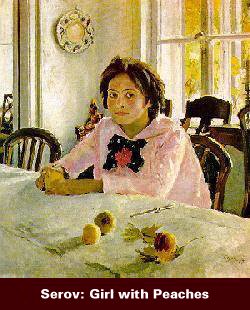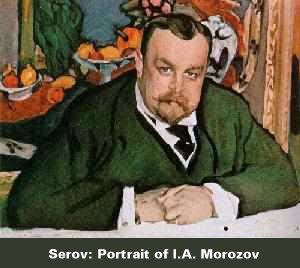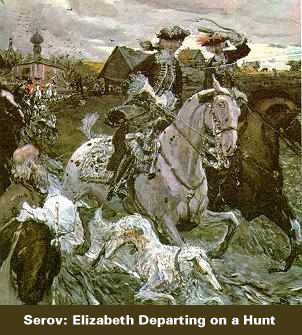

 One of the greatest Russian portrait painters, Serov was born on January 19, 1865, in the family of the composer A. N. Serov, author of the operas Judith, Rogneda, and the Evil Power. As a young boy, Serov might have met many luminaries of Russian culture of the time -- Stasov,
Repin, Ghe, Antokolskii -- who visited his father. Unfortunately, when he was six, his father died, and Serov traveled with his widowed mother to Munich and later to Paris. In Paris, he attracted Repin's attention and started his art education under the master's tutelage. Impressed by the talent of the boy, Repin advised him to return to St. Petersburg and begin formal studies at the Academy of Fine Arts under the famous art teacher P. Chistiakov. Savva Mamontov invited financially destitute Serovs to live at his estate at Abramtsevo. Serov studied at the Academy from 1880 to 1885 and met Mikhail Vrubel there; the painters even shared an atelier. Even though the artist did not finish the Academy, he sufficiently perfected his skills to begin independent work.
One of the greatest Russian portrait painters, Serov was born on January 19, 1865, in the family of the composer A. N. Serov, author of the operas Judith, Rogneda, and the Evil Power. As a young boy, Serov might have met many luminaries of Russian culture of the time -- Stasov,
Repin, Ghe, Antokolskii -- who visited his father. Unfortunately, when he was six, his father died, and Serov traveled with his widowed mother to Munich and later to Paris. In Paris, he attracted Repin's attention and started his art education under the master's tutelage. Impressed by the talent of the boy, Repin advised him to return to St. Petersburg and begin formal studies at the Academy of Fine Arts under the famous art teacher P. Chistiakov. Savva Mamontov invited financially destitute Serovs to live at his estate at Abramtsevo. Serov studied at the Academy from 1880 to 1885 and met Mikhail Vrubel there; the painters even shared an atelier. Even though the artist did not finish the Academy, he sufficiently perfected his skills to begin independent work.
He became famous after exhibiting Girl with Peaches (1887) and Girl Lit by the Sun (1888), both considered to be among the greatest masterpieces of the Tretiakov Gallery. The first canvas, a portrait of Savva Mamontov's daughter, Vera, brings to mind sunny and cheerful portraits by Renoir, but is probably more inspired by the colors of Repin's paintings, particularly They Did not Expect Him. In its colors and juxtaposition of light and shadow, the second canvas is also strongly influenced by Repin's works.
Initially a strong follower of the Wanderers and a supporter of the idea of utilitarian purpose of art, in 1890s Serov, following the example of his mentor, Repin,
disagreed with the Wanderers' "dictatorship" and imposition of standards on the young artists and left the Society; instead, he became close to the World of Art group, which allowed him to exhibit his paintings without interruptions even though he never subscribed to all points of the group's program.
Popularity which Serov gained after showing his first two acclaimed portraits made him an artist in great demand. He painted almost 700 canvasses, including portraits of famous art mecenases, artists, actors and actresses, writers and poets, composers and singers, and politicians. Not surprisingly, the names of his sitters read as a who-is-who in Russian culture and politics of the late nineteenth and early twentieth century: Savva Mamontov (1890), Konstantin Korovin (1891), Ilia Repin (1892), Isaak Levitan (1893), Nikolai Leskov (1894), Nikolai Rimskii-Korsakov (1898), Emperor Nicholas II (1900), Konstantin Pobedonostsev (1902), Anton Chekhov (1903), Sergei Witte (1904), Fiodor Shaliapin (1905), Konstantin Balmont (1905), Maksim Gorkii (1905), M.I. Ermolova (1905), Vasilii Golitsyn (1906), E.L. Nobel (1909), Ivan Morozov (1910), O.K. Orlova (1910), Ida Rubinshtein (1910), V.O. Girshman (1911), and many others.
Even though the portraits account for at least 80% of Serov's works, he also painted
landscapes: Autumn evening (1886), Pine Trees (1890), Autumn (1892), October (1895), and Haystacks (1901),
genre scenes: Woman in a Cart (1896), In the Winter (1898), Woman with a Horse (1898),
historical canvasses: Young Peter Hunting with Dogs (1902), Peter the First (1907), Elizabeth Departing on a Hunt (1912), Peter the Great at the Work Site (1910-11), Peter in Monplaisir (1911),
illustrations to Krylov's fables.
Characteristically, when, at the end of his life, Serov was asked to select works for the World Exhibition in Rome, he chose 15 portraits, explaining: "Only portraits, but that is all my best work."
Serov's fame depends not only on the sheer number of remarkable and memorable works he left, but on his willingness to develop as an artist, to explore new styles and techniques, and to search for new ways of expression without giving up on his convictions or subscribing slavishly to this or that art theory. Chistiakov, who helped many great Russian painters find their own style and who rarely lavished praise on his students, commented that he never had another pupil who would possess not only such an evenly and highly developed feeling for drawing, color, light, shadow, and composition, but also such a clear sense of artist's and art's purpose. Perhaps this sense of purpose and the innate talent of Serov, combined with his open-mindedness and eagerness to experiment, made the artist one of the major figures in Russian painting of the 1880s-1910s.
The three paintings reproduced here can only give an incomplete idea of Serov's development as a painter. Girl with Peaches, inspired by Repin's canvasses, shows Serov's ability to use the lessons learned from the works of the Wanderers in an new way, allowing him to create an intimate and cheerful portrait devoid of social commentary. The portrait of Ivan Morozov, in its vivid colors and the emphasis placed on freer
modeling of the human figure brings to mind postimpressionist works of Matisse as well as many paintings of Russian artists of the same period, for instance Malevich's Self Portrait. Finally, Elizabeth Departing on a Hunt shows Serov's
absorption of the artistic idiom of the World of Art painters, particularly of Alexander Benois. Even more remarkable example of Serov's boldness and striving for new artisitic expression is the famous portrait of Ida Rubinstein (not reproduced here), with its emphasis on line, flatness of the composition, and an overal style commonly associated with the Art Nouveau. [J.J. and A.B.] 

